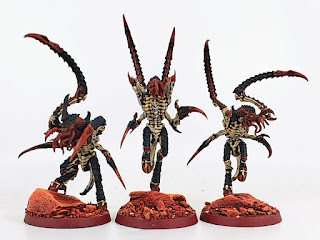The Vallejo dipping washes I use occasionally leave a similar dusty residue that Seraphim Sepia does. So I mixed in some water and Army Painter Quickshade Wash Medium.
I think this solved the issue and actually created a nice finish, particularly on the blue areas.
It's less of an issue at this stage as a lot of these areas are painted over anyway.
But it's good to have solved an issue that can occur when I'd prefer it not to.
Now the hard yards. It was around 9 minutes each to do the bone highlights on the Termagants.
3 hours to get these done and once again my skill with the brush is being called into question. I do wish I had better control, or showed any signs of improvement.
But I think subconsciously I've just become more comfortable with 'good enough'.
Back to the Barbgaunts and we already know this is a 15 minute job.
In fact according to my records I know that it'll take me 6 hours and 20 minutes to get the bone and turquoise highlights done.
I still have the reds, black, any details like teeth, eyes, glow FX, bases and then varnishes on top
It's helpful, but also daunting. Despite the time estimate, which is clearly doable before the end of the hobby season, I have 68 elements to do to get all of the Tyranids done.
But I only have 36 days to do it [not including nights when I can't paint] and I can't imagine ticking off nearly 2 elements a session.
So what seemed like a shoe-in - remember when I thought I'd be able to paint the Kill Team Typhon box as well?
I'm now beginning to doubt I'll get them done in time. Particularly as I have some other non-hobby projects to do before the end of the month.
Well, we'll just have to have our fingers crossed 🤞, hope for the best 🙏 and crack on where we can 🖌
Von Ryan's Leapers have got 4 hours 12 on the clock to go too! 😫





















































